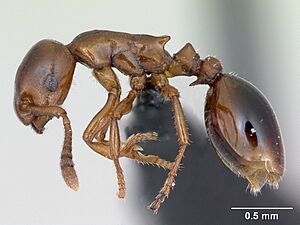Shining guest ant facts for kids
Quick facts for kids Shining guest ant |
|
|---|---|
 |
|
| Formicoxenus nitidulus alate queen | |
| Conservation status | |
| Scientific classification | |
| Genus: |
Formicoxenus
|
| Species: |
nitidulus
|
The Formicoxenus nitidulus, also known as the shining guest ant, is a tiny type of ant. It belongs to a group of ants called Myrmicinae. You can find this ant in many European countries. These include Austria, Denmark, Finland, France, Germany, Great Britain, Italy, Norway, Poland, Russia, Spain, Sweden, and Switzerland.
The International Union for Conservation of Nature says this ant is a vulnerable species. This means it might be at risk of disappearing if we don't protect its home.
What Does It Look Like?
The shining guest ant is very small. It is only about 2 to 3 millimeters long. That's about the size of a few grains of rice!
Its body is a shiny brown-red color. This color is similar to the Formica ants it lives with. But the guest ant's body is much shinier. These tiny ants move quickly across the surface of their nest. They look very small next to the much bigger wood ants.
Where Do They Live?
The shining guest ant lives in many places across Northern Europe and Asia. You can find them from Spain and North Italy all the way to Scandinavia and eastern Siberia. In the British Isles, they are found in Scotland. However, they are not known to live in England, Wales, or Ireland.
These ants live wherever their host ants are found. This is mostly in coniferous forests. Coniferous forests are full of trees like pine and fir.
How Do They Live?
This ant is called the shining guest ant for a good reason. It lives right alongside other types of wood ants. These include species like Formica aquilonia and Formica lugubris. Scientists are still learning a lot about how these guest ants and their hosts interact.
It seems the guest ants raise their own young. They do this in a separate small nest. This small nest is connected to the larger nest of their host ants. The guest ants can leave their small nest through passages. They come out into the open air.
Here, the individual guest ant workers ask for food from the wood ant workers. They might also grab food while the wood ants are sharing it with each other. There can be several guest ant nests inside one big wood ant nest. Each guest ant nest has its own queen and a few dozen workers.
Reproduction
Unlike many other ants, the shining guest ant does not have a "nuptial flight." This is when male and female ants fly high to mate. Instead, the male and female guest ants find each other on the ground. They release special chemicals called pheromones. These pheromones help them attract each other to mate.


